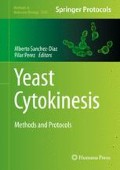Abstract
This chapter deals with the preparation of fission yeast (Schizosaccharomyces) cells for ultrastructural examination. The structure of the cell must be preserved as close to the in vivo situation as possible. This can be achieved by either chemical or cryofixation; the latter will not be dealt with in this chapter. Aldehydes that cross-link proteins and permanganates that besides cross-linking also stain membranous and cell wall structures are used for chemical fixation. This step is followed by dehydration and embedding of the cells in epoxy or acrylic resin. Sectioning of the embedded material produces slices of the cells that have to be stained with heavy metals to increase contrast differences between different structures or can be used for immunodetection of antigens (polysaccharides or proteins) with specific primary antibodies and gold-conjugated secondary antibodies.
Access this chapter
Tax calculation will be finalised at checkout
Purchases are for personal use only
References
Bozzola JJ, Russel LD (1999) Electron microscopy principles and techniques for biologists. Jones and Bartlett Publishers, Sudbury, MA
Hayat MA (1989) Principles and techniques of electron microscopy biological applications. CRC Press, Inc., Boca Raton, FL
Harris JR, Adrian M (1999) Preparation of thin-film frozen-hydrated/vitrified biological specimens for cryoelectron microscopy. Methods Mol Biol 117:31–48
Sipiczki M, Takeo K, Yamaguchi M, Yoshida S, Miklos I (1998) Environmentally controlled dimorphic cycle in a fission yeast. Microbiology 144:1319–1330
Sipiczki M, Yamaguchi M, Grallert A, Takeo K, Zilahi E, Bozsik A, Miklos I (2000) Role of cell shape in determination of the division plane in Schizosaccharomyces pombe: random orientation of septa in spherical cells. J Bacteriol 182:1693–1701
Humbel BM, Konomi M, Takagi T, Kamasawa N, Ishijima SA, Osumi M (2001) In situ localization of β-glucans in the cell wall of Schizosaccharomyces pombe. Yeast 18:433–444
Glauert AM, Lewis PR (1998) Biological specimen preparation for transmission electron microscopy. In: Glauert AM (ed) Practical methods in electron microscopy, vol 17. Portland Press, London
Arnold WN (1991) Rapid permanganate-fixation and alcohol-dehydration of fungal specimens for transmission electron microscopy. J Microbiol Methods 13:17–22
Sutton JS (1968) Potassium permanganate staining of ultrathin sections for electron microscopy. J Ultrastruct Res 21:424–429
Sato M, Kobori K, Ishijima SA, Feng ZH, Hamada K, Shimada S, Osumi M (1996) Schizosaccharomyces pombe is more sensitive to pressure stress than Saccharomyces cerevisiae. Cell Struct Funct 21:167–174
Luft JH (1956) Permanganate - a new fixative for electron microscopy. J Biophys Biochem Cytol 2:799–801
Johnson BF, Yoo BY, Calleja GB (1973) Cell division in yeasts: movement of organelles associated with cell plate growth of Schizosaccharomyces pombe. J Bacteriol 115:358–366
Sipiczki M, Bozsik A (2000) The use of morphomutants to investigate septum formation and cell separation in Schizosaccharomyces pombe. Arch Microbiol 174:386–392
Munoz J, Cortes JCG, Sipiczki M, Ramos M, Clemente-Ramos JA, Moreno MB, Martins IM, Perez P, Ribas JC (2013) Extracellular cell wall β(1,3)glucan is required to couple septation to actomyosin ring contraction. J Cell Biol 203:265–282
Koch G, Schmitt U (2013) Topochemical and electron microscopic analyses on the lignification of individual cell wall layers during wood formation and secondary changes. In: Fromm J (ed) Cellular aspects of wood formation, plant cell monographs, vol 20. Springer, Berlin, pp 41–69
Wang H, Tang X, Liu J, Trautmann S, Balasundaram D, McCollum D, Balasubramanian MK (2002) The multiprotein exocyst complex is essential for cell separation in Schizosaccharomyces pombe. Mol Biol Cell 13:515–529
Finck H (1960) Epoxy resins in electron microscopy. J Biophys Biochem Cytol 7:27–30
Newman GR, Hobot JA (1987) Modern acrylics for post-embedding immunostaining techniques. J Histochem Cytochem 35:971–981
Reynolds ES (1963) The use of lead citrate at high pH as an electron-opaque stain in electron microscopy. J Cell Biol 17:208–212
Watson ML (1958) Staining of tissue sections for electron microscopy with heavy metals. J Biophys Biochem Cytol 4:475–478
Hagler HK (2007) Ultramicrotomy for biological electron microscopy. Methods Mol Biol 369:67–96
Martin-Cuadrado AB, Morrel JL, Konomi M, An H, Petit C, Osumi M, Balasubramanian M, Gould KL, del Rey F, Vazquez de Aldana CR (2005) Role of septins and the exocyst complex in the function of hydrolytic enzymes responsible for fission yeast cell separation. Mol Biol Cell 16:4867–4881
Acknowledgment
This work was supported by the Hungarian Scientific Research Fund grant OTKA 101323
Author information
Authors and Affiliations
Corresponding author
Editor information
Editors and Affiliations
Rights and permissions
Copyright information
© 2016 Springer Science+Business Media New York
About this protocol
Cite this protocol
Sipiczki, M. (2016). Visualization of Fission Yeast Cells by Transmission Electron Microscopy. In: Sanchez-Diaz, A., Perez, P. (eds) Yeast Cytokinesis. Methods in Molecular Biology, vol 1369. Humana Press, New York, NY. https://doi.org/10.1007/978-1-4939-3145-3_8
Download citation
DOI: https://doi.org/10.1007/978-1-4939-3145-3_8
Publisher Name: Humana Press, New York, NY
Print ISBN: 978-1-4939-3144-6
Online ISBN: 978-1-4939-3145-3
eBook Packages: Springer Protocols

